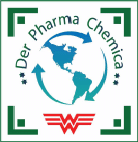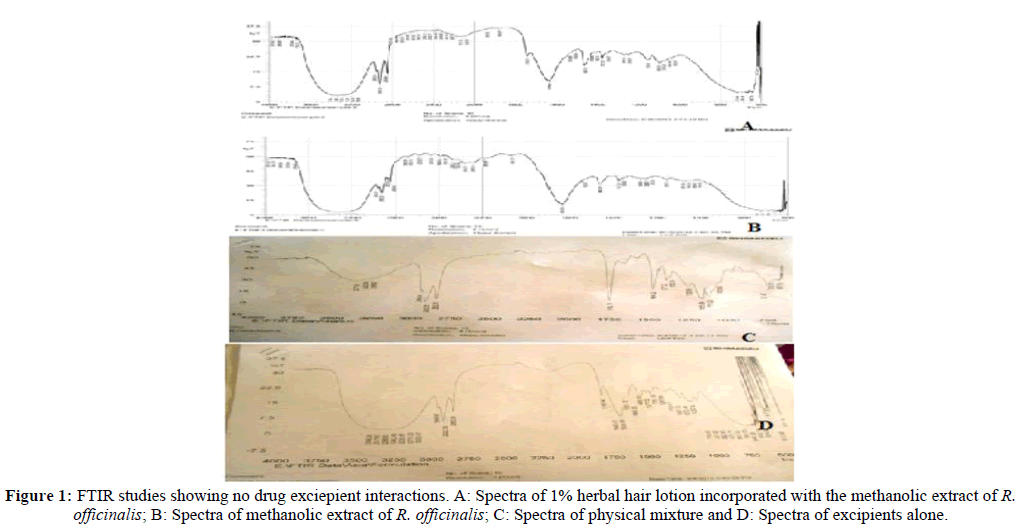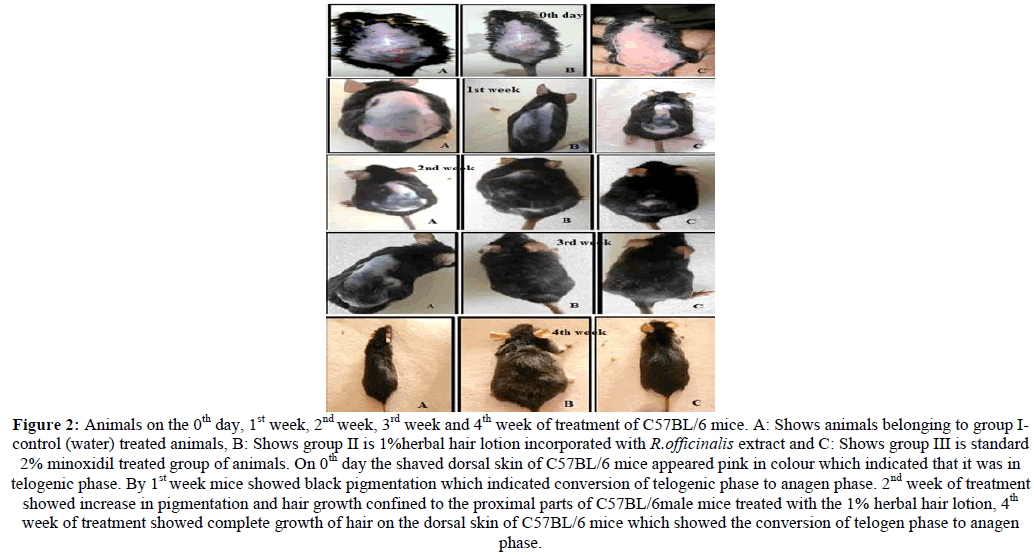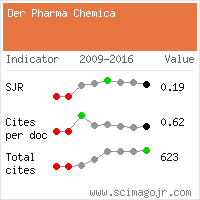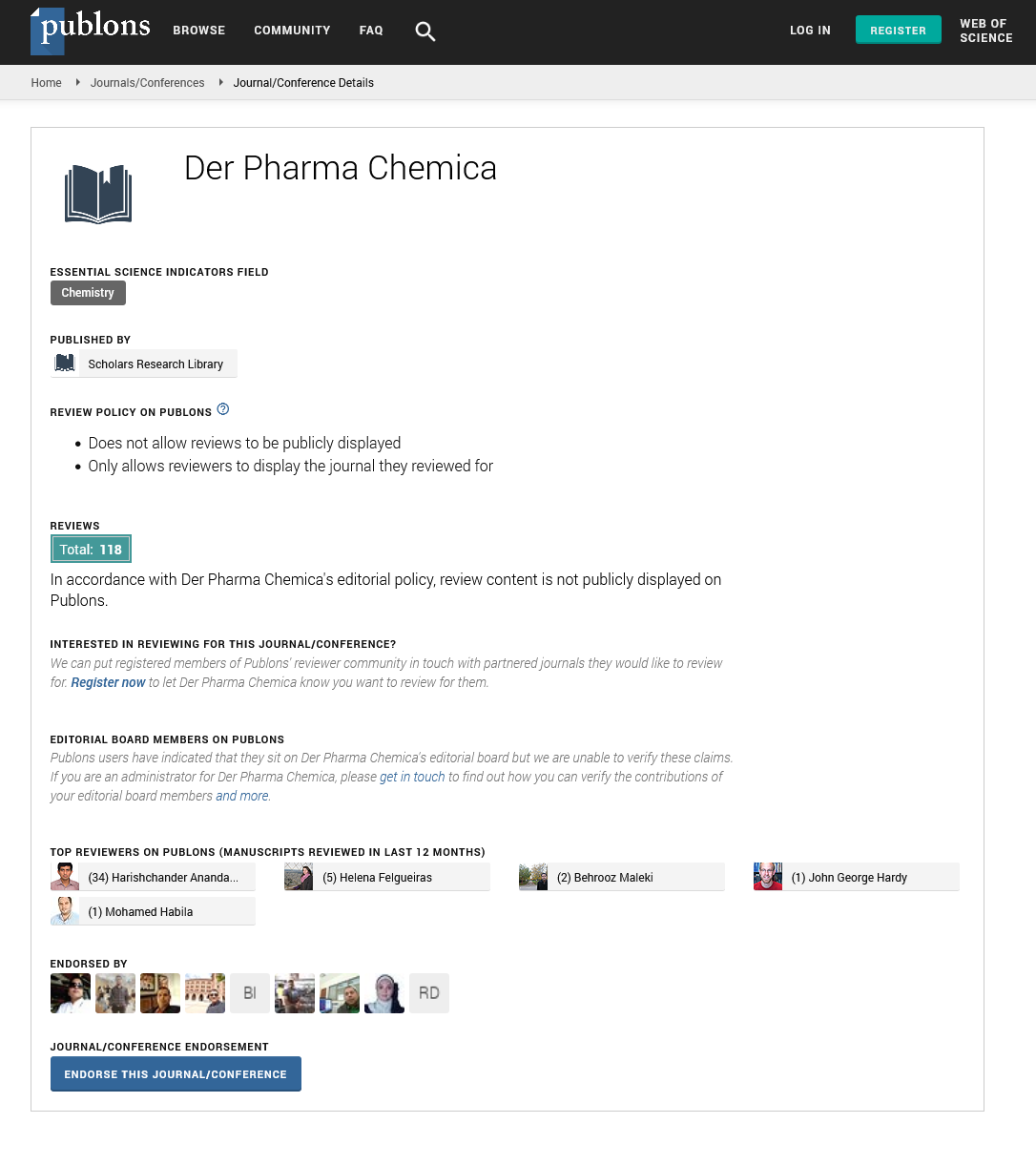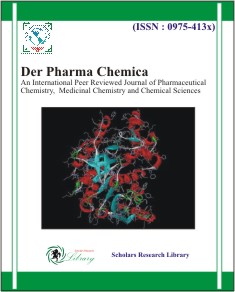Research Article - Der Pharma Chemica ( 2025) Volume 17, Issue 1
Evaluation of Hair Growth Promotion Activity of Rosmarinus officinalis Hair Lotion in C57BL/6 Mice
Asia Begum1, Syed Shaffath Ali1, Anoop Kumar N2 and Sandhya S2*2Research Centre, Kerala University of Health Sciences, Thrissur, Kerala, India
Sandhya S, Research Centre, Kerala University of Health Sciences, Thrissur, Kerala, India, Email: drsanpharm@gmail.com
Received: 30-Sep-2024, Manuscript No. DPC-23-33762; Editor assigned: 03-Oct-2024, Pre QC No. DPC-23-33762 (PQ); Reviewed: 17-Oct-2024, QC No. DPC-23-33762; Revised: 01-Feb-2025, Manuscript No. DPC-23-33762 (R); Published: 28-Feb-2025, DOI: 10.4172/0975-413X.17.1.614-620
Abstract
Rosmarinus officinalis is a common household plant with needle-like leaves and white flowers belongs to the family Lamiaceae and has various medicinal properties including cardiovascular, nervous disorders, gastrointestinal, genitourinary conditions, liver diseases and scalp treatment. The present research is envisaged on formulation and evaluation of 1% herbal hair lotion incorporated with methanolic extract of R. officinalis. The aerial parts of R. officinalis was extracted with methanol and subjected to preliminary chemical tests. It showed the presence of proteins, aminoacids, fats and oils, steroids, glycosides, phenolic compounds, flavonoids, volatile oil and vitamins. The extract was formulated to a suitable hair lotion and then evaluated for its various quality control parameters. Finally, the lotion was evaluated for hair growth promoting activity on C57BL/6 mice, using water as control and 2% minoxidil hair lotion as standard. It was observed that the formulated 1% herbal hair lotion passed all the evaluation parameters and showed a significant hair growth promoting activity than the standard drug treated animals. From this study it can be concluded that R. officinalis can be considered to be a better choice for the synthetic hair growth promoters which have unwanted side effects.
Keywords
Anagen phase; Telogen phase; Stability studies; Globule size; Histology
Introduction
Hair is one of the fundamental parts of the body derived from ectoderm of the skin, is protective appendages on the body and considered accessory structure of the integument along with sebaceous glands, sweat glands and nails. A typical hair shaft is made up of three essential layers namely cuticle, medulla and cortex. The cuticle is the outermost layer that protects the medulla and cortex and is a transparent structure that gives a shiny appearance. Cortex is the middle layer and it possesses a protein called keratin and coloring pigments. The cortex determines the shape and size of the hair shaft. Medulla is the innermost layer constituted by large size cells. The hair growth and loss is completely random and is not seasonal or cyclic. There are four stages of hair growth which include anagen (active growth phase), catagen (transitional phase), telogen (resting phase) and exogen (shedding phase). The main problems associated with hair are pigmentation problems (Fading), dandruff and falling of hair. Nutrition has a profound effect on quality and quantity of hair. Poor nutrition may result in dull, dry, brittle or thin hair coat. Minoxidil is a synthetic drug generally preferred for the treatment of hair loss and it is reported that after 5 years use of 2% and 3% topical minoxidil, the improvement has been shown to peak in one year with a slow decline in regrowth over subsequent years. Potential hair growth property is exhibited by the plants possessing antiandrogenic activity (testosterone, 5-alpha reductase inhibition) and antioxidant activity produced by flavonoids.
Rosmarinus officinalis Albus (Lamiaceae) is a common dense, evergreen, aromatic shrub with fragrant, needle-like leaves and white colored flowers. The plant is also known as garden rosemary, polar plant, compass-weed, compass plant. Rosemary is indigenous to South Europe and Asia. It is cultivated in Mediterranean basin and India. Chemical properties of the plant include ethereal oil with main constituent including camphene, camphor, cineol and borneol. it is reported to contain flavoinoids like 6-methoxygenkwanine, Apigenine, Diosmetine, Diosmine, Genkwanine, Hispiduline, Luteoline, Sinensetine It also contain resin, bitters matter, tannins and di and triterpenoids like carnosolic acid, picrosalvine, rosmariquinone, oleanolic acid, ursolic acid. The plant is used as cholagogue, diaphoretic, digestant, diuretic, esmmenagogue, laxative, toniccarminative, rubifacient, stimulant and as flavouring agent for liniments, hair lotions, inhaler, soaps and cosmetics. Hair loss is a dermatological disorder that has been known for more than thousand years. It is seen all over the world and affects approximately 0.2%-2% of the world population. Hair growth problems can affect human physical and mental health and are of particular relevance during the aging process. In an effort to determine such problems, an attempt was done to find plants having hair growth promoting activity and thus found that the volatile oil of R. officinalis is widely used for the above mentioned purpose. Hence this formed the basis for the selection of the plant and converting into a suitable topical dosage form for the evaluation of its hair growth potentiality [1,2].
Materials and Methods
Methodology
Collection and authentication: The fresh plant of Rosmarinus officinalis Albus was collected from Central institute of medicinal and aromatic plants in the region of Field station, Allasandra Bangalore, India, in the month of December to January. The plant material was identified and authenticated by Mr. Siddulu lecturer of Botany, Nagarjuna government degree college in Nalgonda, Telangana. The herbarium specimen was prepared and deposited in the department of pharmacognosy, under the vocher no: NCOP/Ph’cog/2011-2012/042, for future references.
Procurement of experimental animals and its maintenance: Healthy C57BL/6 male mice (7 weeks old, 6 mice per group) were obtained from Mahaveera experimental animals enterprises (Hyderabad). Mice were cared in a controlled barrier facility within Nalanda college of pharmacy, where the temperature (23ºC ± 2ºC), humidity (35%-60%) and photoperiod (12 h light, 12 h darkness cycle) were kept constant. The animal study was performed in accordance with the institutional guidelines. Ethical clearance for the use of animals was obtained from Institutional animal ethical committee under the reference no: NCOP/IAEC/Approval/53/2012, Date: 24.03.2012. Sacrificed animals were disposed as per committee for the purpose of control and supervision of experiments on animals’ guidelines [3].
Extraction: About 600 gm of the whole areal part of the plant was taken and extracted with methanol for 32 hrs. The thick mass obtained was evaporated with help of rotary vacuum evaporator and % yield was calculated. Further the preliminary chemical tests were performed to identify the chemical nature of the extract.
Formulation and evaluation of 1% herbal hair lotion
Formula used for the preparation of 1% herbal hair lotion was: oil phase: Stearic acid 2.5%, coconut oil 3.5%, tween60 2%, propyl paraben 0.126%, methyl parben 0.126%. Aqueous phase: Water 8%, triethanolamine1% and plant extract 1%. The required ingredients for oil phase and aqueous phase were taken and heated at 50ºC separately. Then to the aqueous phase the required amount of plant extract was added and mixed thoroughly at 50ºC. Further the oil phase was mixed with aqueous phase and stirred well till the desired consistency was obtained and it was stored in well closed air tight container [4].
Evaluation parameters for 1% herbal lotion:
Organoleptic characters: By visual appearance, colour and odour was noted.
Presence of foreign particles/grittiness: A small amount of lotion was taken and spread on a glass slide free from grease and was observed against diffused light to check for presence of foreign particles.
Determination of pH 7: The pH of prepared lotion was determined using a pH meter at 27ºC.
Irritancy: The animals C57BL6 mice caged in polypropylene cages and supplied with fresh food and water during the test period, 24 hours prior to test and then the hair from the neck and dorsal skin was shaved to expose sufficient large test area. The test site was cleaned with surgical spirit then lotion was applied to test area. The test site was observed for erythema and edema for 24 hrs; 48 hrs; and 72 hrs after application.
Globule size determination: 1 ml of lotion was diluted to 10 ml with glycerine and a few drops of this were transferred on to a glass slide was observed under a microscope. Then the diameters of 20 particles were determined randomly and average value was calculated.
Viscosity: The viscosity of formulated lotion was measured by brook field viscometer (Model-RVTP) by using spindle CP-18 at varying speed and shear rates. The measurements were made over the range of speed setting at 5-10RPM with 60 secs between two successive speeds as equilibration with shear rate ranging from 0.20 sec-1 to 1.0 sec-1. Viscosity determinations were performed in a room temperature maintained at 25ºC ± 2ºC.
Stability studies by freeze thaw method: The formulated product was stored in chilled temperature at 4°C and then it was maintained in room temperature until its temperature normalized to 28°C likewise three cycles were performed and viscosity was measured by Brook field viscometer (Model-RVTP) [5].
Fourier Transform Infrared Spectroscopy (FT-IR): FTIR was performed to evaluate the drug excipient interactions. KBr pellets were prepared by gently mixing 1 mg sample with 100 mg KBr and the spectrum were taken and compared.
Sterility test: As the herbal hair lotions are more prone to microbial attack the formulation was subjected for microbial contamination test. Nutrient agar was prepared and lotion was loaded into the sterile discs then incubated for 24 hrs at 32°C. The growth for microbes was observed.
Spreadability: The formulation was placed over the glass plate of 20 cm × 5 cm and another glass plate of the same dimension was placed on the top of the lotion such that the formulation was sandwiched between the two slides by placing a weight of 100 g uniformly on the slides. The weight was removed and the excess of lotion was scrapped off. Two slides in position were fixed to a stand at a 45º angle without the slightest disturbance so that only the lower slide was held firmly by the clamp, allowing the upper slide to slip off freely with the help of 20 g weight tied to the upper slide. The time taken for the upper slide to separate away from the lower glass plate under the direction of the weight was noted as per ICH guidelines. Experiment was done in triplicate and spreadibility was calculated as follows: S=W × L/T, Where, S=spreadibility, L=length of the glass plate, W=weight tied to the upper plate, T=time taken (sec).
Hair growth promoting activity: C57BL/6 male mice weighing 25 g-30 g were taken and were maintained in condition below room temperature. They were caged and provided with food and water ad libitium. The hair on dorsal portion was removed using hair remover cream in an area of 3 cm2. The animals were divided into 5 groups with 6 animals in each group. Group I was applied with water (control). Group II was applied with 1% Rosmarinus officinalis Albus hair lotion. Group III was applied with standard (2% Minoxidil). The drug was applied twice daily for 30 days on depilated area. At the end of each week, one animal per group was sacrificed by means of cervical dislocation and the animals were observed for hair growth and change in protein content [6].
The parameters observed were:
• Qualitative observation of hair growth.
• Effect of methanolic extract of Rosmarinus officinalis Albus on hair growth
• Determination of hair length
• Change in concentration of total protein content
• Determination of hair weight
C57BL/6 mice were taken and dorsal skin hair was removed by using hair removing cream. The prepared 1% herbal hair lotion was applied topically on the surface of the dorsal skin of mice twice a day. Then the hair growth promoting activity was determined. The number of hair follicle and length of hair was determined and compared with the control and standard.
Statistical analysis: Averages ± S.E.M. of the means were calculated; statistical analysis of results was performed by Dunnet multiple comparison test (one-way analysis of variance, ANOVA), compared with control using Instat graph pad #3. The Values of **P<0.01 were considered significant [7].
Results
The percentage yield obtained for the methanolic extract of aerial parts of the plant was found to be 20% w/w.
Phytochemical screening: The methanolic extract of the plant showed the presence of proteins, aminoacids, fats and oils, steroids, glycosides, phenolic compounds, flavonoids, volatile oil and vitamins.
Evaluation of 1% herbal hair lotion: The color of the lotion was found to be light green and odour was pleasant. The lotion was found to be free from grittiness and had smooth texture with a pH of 6.82. The formulated 1% herbal lotion the animals did not show any kind of primary skin irritation, sensitivity, erythema or edema even after 72 hrs of application. The average globule size of the lotion was found to be 72.8 μ. Viscosity value was found to be 10.8 CPs at 10 RPM. Freeze thaw method was performed for the stability determination of lotion by using spindle no.18. and finally after the performance of 3 cycles it was found that there was no much variation in the globule size by microscopic observation and hence it was confirmed that the lotion was stable. 1st cycle showed a viscosity of 10.8 CPs, 2nd cycle-10.2 CPs and 3rd cycle-10.6 CPs. FTIR study concluded that all the peaks of the formulated lotion with extract, lotion without extract, physical mixture and pure drugs were observed (Table 1). The result concluded that there was no drug exceipients interaction (Figure 1). The results of sterility testing depicted that the prepared 1% herbal hair lotion was free of microbial contamination. The spreadability value obtained was within the range and it was found to be 30.02 g.cm/sec ± 0.012 g.cm/sec. Hence the 1% herbal hair lotion passed the spreadability test [8].
| S. No | Types of samples | Frequency cm-1 | Types of vibrations |
|---|---|---|---|
| 1 | Hair lotion | 2918.4 | CH3 |
| 2850.88 | |||
| 1743.71 | C=O | ||
| 1635 | C-C | ||
| 2 | Extract | 2956.97 | CH3 |
| 2920.32 | |||
| 1633 | C-C | ||
| 3 | Physical mixture | 3377.47 | CH3 |
| 2965.04 | |||
| 2922.25 | |||
| 174371 | C=O | ||
| 4 | Lotion without extract | 3356.25 | CH3 |
| 2956.97 | |||
| 2922.25 | |||
| 2852.61 | |||
| 1743.64 | C=O | ||
| 1643.41 | C-C | ||
| 1635.69 |
Table 1: Fourier transform infrared spectroscopy.
Evaluation of herbal hair lotion for hair growth
Qualitative observation of hair growth: It was observed that the number of days taken for hair growth initiation and completion by the animals treated with 1% herbal hair lotion incorporated with R. officinalis was better than the standard 2% minoxidil treated group of animals.
Effect of herbal hair lotion on C57BL/6 mice: On the 0th day, the shaved dorsal skin of C57BL/6 mice appears in pink colored which indicated that it was in telogenic phase. On the first week of treatment the dorsal skin of C57BL/6 mice showed black pigmentation which indicated conversion of telogenic phase to anagen phase. The black pigmentation was found to be more in test and standard treated group of animals than the control. Second week of treatment showed increased pigmentation and hair growth in test and standard group of animals. Third week of treatment showed that in control treated group the hair growth was not confined to the proximal parts of C57BL/6mice whereas in 1% hair lotion and standard treated group showed increase in the hair growth which was confined to the proximal parts of C57BL/6 mice. Fourth week of treatment showed complete growth of hair on the dorsal skin of C57BL/6 mice which confirmed the conversion of telogen phase to anagen phase (Table 2, Figure 2) [9].
| Treatment group | Dose | Number of days taken to initiate hair growth (avg. of group) | Number of days taken to complete hair growth (avg. of group) |
|---|---|---|---|
| Group I | Water | 7 | 27 |
| Group II | 1% | 3 | 15 |
| Group III | 2% | 2 | 16 |
Table 2: Qualitative observation of hair growth of 1% herbal hair lotion.
Figure 2. Animals on the 0th day, 1st week, 2nd week, 3rd week and 4th week of treatment of C57BL/6 mice. A: Shows animals belonging to group I-control (water) treated animals, B: Shows group II is 1%herbal hair lotion incorporated with R. officinalis extract and C: Shows group III is standard 2% minoxidil treated group of animals. On 0th day the shaved dorsal skin of C57BL/6 mice appeared pink in colour which indicated that it was in telogenic phase. By 1st week mice showed black pigmentation which indicated conversion of telogenic phase to anagen phase. 2nd week of treatment showed increase in pigmentation and hair growth confined to the proximal parts of C57BL/6male mice treated with the 1% herbal hair lotion, 4th week of treatment showed complete growth of hair on the dorsal skin of C57BL/6 mice which showed the conversion of telogen phase to anagen phase.
Determination of hair length: The length of hairs of animals treated with 1% herbal hair lotion treated group was significantly longer than that of control group treated animals. By the end of fourth week the animals treated with 1% herbal hair lotion showed hair length of 76.3 cm ± 0.3457**cm, whereas 2% minoxidil treated animals showed a hair length of only 45.86 cm ± 0**cm which was almost similar to that of the control treated group of animals for which the hair length was observed to be 44.32 cm ± 0 cm (Table 3).
| No. of weeks | Group 1 (cm) | Group II (cm) | Group III (cm) |
|---|---|---|---|
| 2nd week | 22.23 ± 0 | 30.372 ± 0.34** | 24.45 ± 0** |
| 3rd week | 30.65 ± 0 | 57.70 ± 1.033** | 32.56 ± 0** |
| 4th week | 44.32 ± 0 | 76.3 ± 0.3457** | 45.86 ± 0** |
Table 3: Determination of hair length.
Determination of total protein content in blood: It was observed that the group of animals treated with 1% herbal hair lotion showed a remarkable increase in total protein content in blood from the 10th day to 30th day of treatment where as in the case of animals treated with control and standard showed negligible increase in protein content (Table 4).
| Treated groups | Concentration | Total protein content in blood at 660 nm (g/dl) | ||
|---|---|---|---|---|
| 10th day | 20th day | 30th day | ||
| Group I | Water | 0.96 | 1.21 | 1.74 |
| Group II | 1% | 1.724 | 2.68 | 4 |
| Group III | 2% | 0.98 | 1.21 | 1.73 |
Table 4: Determination of total protein content in blood for formulated animals.
Determination of hair weight: The weight of newly grown hairs in test group treated animals were measured and compared with that of the control and standard group treated animals. It was found that weight of hair was highest for 1% herbal hair lotion treated mice group. The weight of hair was determined to be 52, 55 and 54 mg/cm2 area of dorsal skin for formulation treated mice groups, respectively while it was found 46.741 mg/cm2 area of dorsal skin for the control group. The standard treated group of animals had shown a similar response as that of the control group of animals (Table 5).
| No. of weeks | Group I | Group II | Group III |
|---|---|---|---|
| 1 week | 41 | 46 | 42 |
| 2 week | 44 | 53 | 46 |
| 3 week | 47 | 55 | 49 |
| 4 week | 50 | 57 | 52 |
Table 5: Determination of hair weight.
Histological studies
Observations of induction of anagen phase in telogenic C57BL/6 male mice: In the case of the animals treated with 1% herbal hair lotion the Longitudinal Section (LS) and Transverse Section (TS) 0th day stained with haematoxylin and eosin showed less number of hair follicle which indicated that it was in telogenic phase. On the 1st week of treatment the skin section stained with haematoxylin and eosin which showed increase in number of hair follicle which indicated that telogenic phase started converting to anagen phase. By 2nd week the histological studies revealed an increase in number of hair follicle and hair shaft elongation in epidermal layer had commenced. On the 3rd week the skin histology revealed an increase in number of hair follicle and started hair shaft elongation extended to the sub cutis layer. The histology sections taken on animals of 4th week exhibited increase in number of hair follicle and showed increased in hair shaft elongation. The skin histology of group of animals treated with control and standard drug though showed induction of anagen phase, but was slow when compared to the test treated group of animals (Figure 3).
Figure 3. Longitudinal Section (LS)and Transverse Section (TS) of the skin of C57BL/6 mice stained with H and E stain on the 0th day, 1st week, 2nd week, 3rd week and 4th week of treatment. A shows skin section of animals belonging to group I-control (water) treated animals, B shows Group II is 1% herbal hair lotion incorporated with R. officinalis extract and C shows group III is standard 2% minoxidil treated group of animals. Indicates the hair follicles and induction of anagen phase in telogenic C57BL/6 male mice treated by the 1% herbal hair lotion.
Hair follicle count: The qualitative observation of hair growth revealed an increase in the number and the size of hair follicle which was observed during anagen phase induction in the animals treated with 1% herbal hair lotion. The anagen phase is associated with increase in the size and the number of hair follicles that lie deep in the subcutis compared to that of telogen phase where hair follicle lies in dermis only. The number of hair follicles of the relative area (0.09 mm2) in Rosmarinus officinalis Albus 1% hair lotion treated group was higher than in the control and the standard group treated animals (Table 6).
| No. of weeks | Group I | Group II | Group III |
|---|---|---|---|
| 1 week | 1.33 ± 0.5774 | 3 ± 1.000ns | 3.666 ± 0.5774ns |
| 2 week | 3.666 ± 0.5774 | 10 ± 1.000** | 11.666 ± 1.528** |
| 3 week | 5 ± 1.000 | 11 ± 1.000** | 13.666 ± 1.528** |
| 4 week | 10 ± 1.000 | 16 ± 1.000** | 18.333 ± 1.528** |
Table 6: Quantitative observation of hair follicle count.
Discussion
The demands for hair growth promoting agents led to a multibillion-dollar industry. In Japan, approximately 60% of total Japanese male population is suffering from hair loss. The estimated market value is 4-5 billion dollars per year in Japan. Although hair loss disorders are not life-threatening, they are extremely emotionally distressing disease which makes afflicted patients vulnerable. Minoxidil is a popular hair growth promoting drug, but it is reported that it can cause adverse dermatological effects such as pruritis, dryness, scaling, local irritation, dermatitis. It is reported that minoxidil is efficacious in promoting hair growth in patients with androgenic alopecia by inducing hair follicles to undergo transition from the early to late anagen phase. Minoxidil limit their therapeutic uses due to their undesirable side-effects and low efficacy for treating hair loss or hair thinning. Various hormones, growth factors and development related molecules are involved in hair follicle growth. C57BL/6 mice are useful models for screening hair growth promoting agents, as their truncal pigmentation is dependent on their follicular melanocytes, producing pigment only during anagen phase. Conversion of telogen phase to anagen phase can be determined or identified by the conversion of pink coloured skin to black pigmentation. C57BL6/N mice of 7 week-old which were in the stable telogen phase were selected for this study [10].
The 1% herbal hair lotion incorporated with methanolic extract of aerial parts of Rosmarinus officinalis was formulated and evaluated. Organoleptic evaluation of products plays an important role in judging the censoring acceptability or rejection of products in the market. The 1% hair lotion possesses a pleasant colour and odour that can be easily acceptable. The organoleptic characters were found to be compatable and preparation had no gritty particles and had a smooth texture. The pH of hair products can affect the hair condition and cause damage by breakage. The pH of 1% hair lotion has been shown to be important for improving and enhancing the qualities of hair, minimizing irritation and stabilizing the ecological balance of the scalp. Mild acidic pH prevents swelling and promotes tightening of the scales, there by inducing shine. The result of the 1% hair lotion had a pH of 6.82 which is near to the skin pH. It was observed that the hair of the animals treated with the 1% herbal hair lotion showed a shiny and healthy texture when compared to the hair of control and standard treated animals. Skin irritancy was performed on C57BL/6 male mice by patch test. The results showed that the formulation was devoid of any primary skin irritation or sensation or erythema or edema even after 72 hrs of application. Growth in the globule size after the preparation of an emulsion is an indication of its physical instability. 1% hair lotion formulation showed a stable globule size in the first and third week of the study which indicates that the lotion was stable. Viscosity is a measure of a fluid’s internal friction when one layer of fluid is forced to move in over another layer. Viscosity affects both the cleansing efficiency and the consumer perception of a product. The viscosity of 1% hair lotion was checked and it was observed that it was sticky in nature, so it sticks to the hair and shows the activity. Viscosity was found to be normal range hence it doesn’t cause any irritation to hair. FTIR study showed that the CH3 and C-C peaks were found in the similar wavelength for the 1% herbal hair lotion, crude extract, physical mixture and exciepients alone which conclude that there was no drug-excipient interaction. The results obtained for spreadability indicate that the lotion was easily spreadable by small amount of shear. The formulation showed the potent hair growth promoting activity than the standard 2% minoxidil hair lotion. The animals treated with the 1% herbal hair lotion showed a faster onset of action and completion of hair growth.
Conclusion
The quality of the hair, its appearance, length and weight also was far better than the animals treated with the control and standard drugs. It was observed that an increase in total protein content was seen in the animals treated with the test lotion. Hence it formed the basis for a healthy, long shiny hair with good texture. From the phytochemical screening it was found that the extract consists of volatile oils, flavonoids, alkaloids, saponins and phenolic compounds. So, this potent hair promoting activity may be attributed to the presence of these phytoconstituents.
Acknowledgement
The authors express their deep sense of gratitude to the management of Nalanda college of pharmacy, Nalgonda for providing the facilities to perform the intended research work.
References
- Ebling FJ. Dermatol Clin. 1987; 5(3): p. 467-481.
[Crossref] [Google Scholar] [PubMed]
- Sandhya S, Chandrasekhar J, David B, et al. J Nat Remedies. 2012;12(1): p. 1-11.
- Sandhya S, Chandrasekhar J, Vinod KR, et al. Indian J Nat Remedies. 2012; 3(1): p. 14-19.
- Saito H. Pharmacol Res. 2000; 41(5): p. 515-529.
[Crossref] [Google Scholar] [PubMed]
- Tyler VE. Public Health Nutr. 2000; 3(4): p. 447-452.
[Crossref] [Google Scholar] [PubMed]
- Patel S, Sharma V, Chauhan NS, et al. Avicenna J Phytomed. 2015; 5(6): p. 512.
[Crossref] [Google Scholar] [PubMed]
- Kumar KK, Sasikanth K, Sabareesh M, et al. Asian J Pharm Clin Res. 2011;4(2): p. 93-98.
- Vinod KR, Santhosha D, Anbazhagan S. Int J Pharm Pharm Sci. 2011; 3(2): p. 29-33.
- Sandhya S, Chandra SJ, Vinod KR, et al. Asian Pac J Trop Biomed. 2012; 2(1): p. 296-304.
- Park HJ, Zhang N, Park DK. J Ethnopharmacol. 2011; 135(2): p. 369-375.
